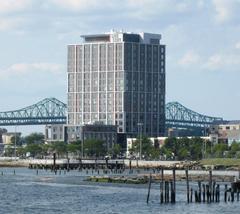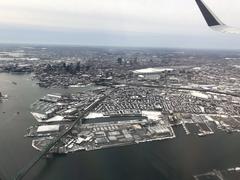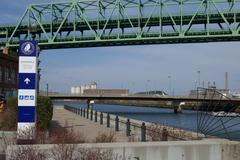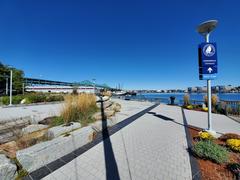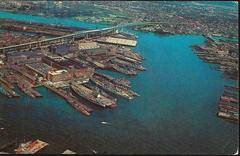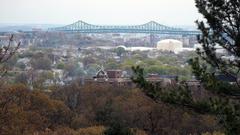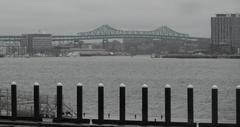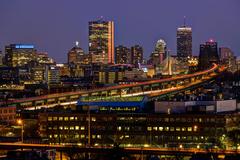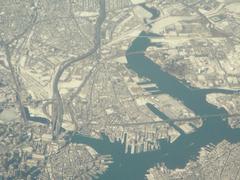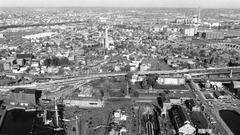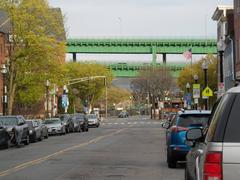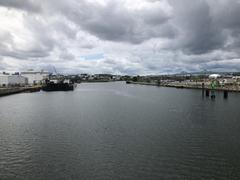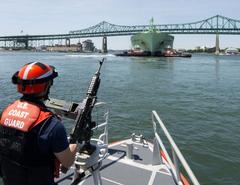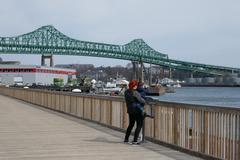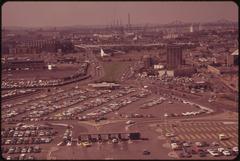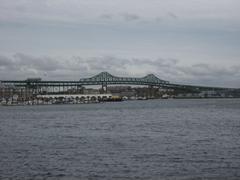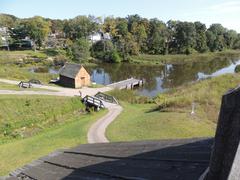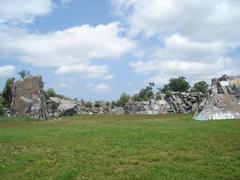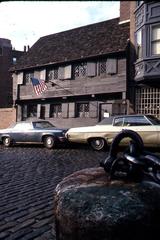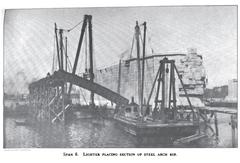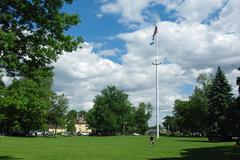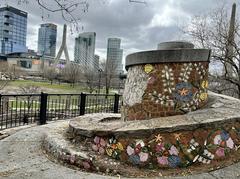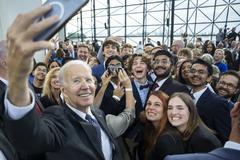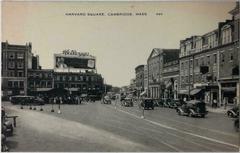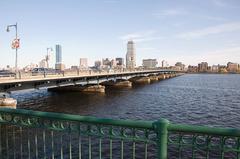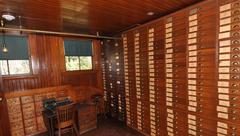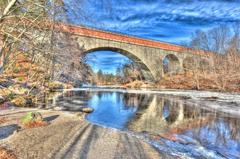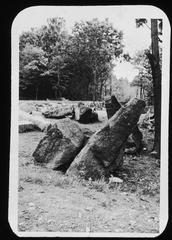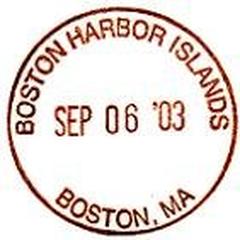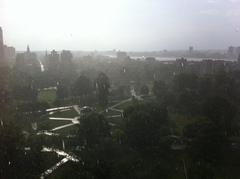
Visiting Maurice J. Tobin Memorial Bridge in Boston: Hours, Tickets, and Tips
Date: 01/08/2024
Introduction
The Maurice J. Tobin Memorial Bridge, commonly referred to as the Tobin Bridge, is a significant infrastructure landmark in Boston, Massachusetts. Connecting the Charlestown neighborhood to the city of Chelsea, the bridge spans the Mystic River and has been a vital transportation link since its opening in 1950. Named after Maurice J. Tobin, a former Mayor of Boston and Governor of Massachusetts, the bridge is notable for its historical, architectural, economic, and cultural importance. It serves as a critical route for commuters and freight, facilitating efficient travel and commerce in the Greater Boston area. This comprehensive guide explores the bridge’s rich history, its engineering marvels, and provides practical information for visitors, making it an essential read for history enthusiasts and travelers alike. With its towering presence and distinctive design, the Tobin Bridge also stands as a symbol of Boston’s industrial heritage and ongoing evolution (Wikipedia, Celebrate Boston).
Table of Contents
- Introduction
- History of the Maurice J. Tobin Memorial Bridge
- Financing and Management
- Renaming and Tolls
- Incidents and Safety Measures
- Modern Developments
- Visitor Information
- Cultural and Historical Significance
- Conclusion
- FAQ
History of the Maurice J. Tobin Memorial Bridge
Origins and Construction
The Maurice J. Tobin Memorial Bridge, originally known as the Mystic River Bridge, spans the Mystic River from Charlestown to Chelsea, Massachusetts. Construction took place between 1948 and 1950, officially opening to traffic on February 2, 1950. The bridge was built to replace the former Chelsea Bridge, which had become inadequate for the increasing traffic demands of the time (Wikipedia). The construction of the bridge was authorized by Maurice J. Tobin during his tenure as Governor of Massachusetts (1945-1947). Tobin, who later served as the U.S. Secretary of Labor under President Harry Truman, was a significant figure in Boston’s political landscape. His support for labor laws and infrastructure projects left a lasting legacy, culminating in the bridge being renamed in his honor in 1967 (Celebrate Boston).
Design and Structure
The Tobin Bridge is notable for its length and design. It spans more than two miles (3.2 km) and is the largest bridge in New England. The main span is a cantilever through truss, a three-span unit totaling 1,524 feet with an 800-foot center span. Additionally, there is a large 439-foot fixed through truss span over the Little Mystic Channel, with most of the remaining spans being deck plate girders (Historic Bridges). The bridge features a double-deck design, with three lanes of traffic on each level. Northbound traffic travels on the lower level, while southbound traffic uses the upper level. The 36-foot-wide roadway is designed to handle significant traffic volumes, connecting U.S. Route 1 with downtown Boston and the Big Dig tunnel system (Celebrate Boston).
Financing and Management
The construction of the Tobin Bridge was financed through $27 million in bonds issued by the Mystic River Bridge Authority. According to the statute enacted on May 23, 1946, the bridge would be turned over to the Massachusetts Department of Public Works once the bonds were retired. This transfer occurred in 1956, and the bridge became part of the state highway system, maintained and operated by the department (Wikipedia). In 1959, the Massachusetts Port Authority (MassPort) took over the operation of the bridge, along with Logan Airport, Hanscom Field, and the Port of Boston. This transaction was humorously described by State Treasurer Kennedy as a “bigger steal than the Brinks robbery” due to its $44 million valuation (Celebrate Boston).
Renaming and Tolls
In 1967, the bridge was renamed the Maurice J. Tobin Memorial Bridge to honor the former Boston mayor and Massachusetts governor. Despite the renaming, the bridge continued to be commonly referred to as the Tobin Bridge or its former name, the Mystic River Bridge (Wikipedia). Initially, the bridge had tolls to cover its construction and maintenance costs. The southbound tolls were increased to 25 cents in the 1980s to cover the closing of the northbound toll plaza. Starting in the early 1990s, tolls increased sharply to help pay for the Big Dig project. In 2014, the tollbooths were closed and replaced with an all-electronic and cashless tolling system. The current toll rate is $1.25 in both directions, with a 30-cent surcharge for pay-by-mail (Wikipedia).
Incidents and Safety Measures
Over its more than 50-year lifespan, the Tobin Bridge has experienced several notable incidents. In 1973, a gravel truck traveling on the lower deck crashed into a support, causing the upper deck to collapse onto the truck and killing the driver. The bridge was closed for more than two months for repairs before reopening later that year (Wikipedia). Suicides and attempted suicides have also been a concern for authorities. The design and weight of the bridge make it impossible to add suicide prevention devices. As a result, MassDOT employees are trained to monitor security cameras and watch for any vehicles that stop on the bridge for any reason (Wikipedia).
Modern Developments
In recent years, the Tobin Bridge has undergone several modernizations to improve its functionality and safety. In 2010, legislation was passed to transfer the bridge from MassPort to the new Massachusetts Department of Transportation (MassDOT). This transfer became effective on January 1, 2010 (Wikipedia). The most significant modernization was the implementation of the all-electronic tolling system in 2014. This system uses E-ZPass for toll collection at the current rate or “pay-by-mail” where an invoice is sent to motorists’ homes via license plate number recognition. This change was part of a broader initiative by MassDOT to convert all toll roads and bridges in the Commonwealth to automatic open road tolling (Wikipedia).
Visitor Information
Visiting Hours and Tickets
The Tobin Bridge is accessible 24/7, making it easy for visitors to drive across at any time. While there are no specific visiting hours or tickets required to cross the bridge, tolls are applicable as mentioned above. For the best views, consider driving across during daylight hours.
Travel Tips
- E-ZPass: To avoid additional fees, consider obtaining an E-ZPass, which streamlines the toll payment process.
- Traffic: Be mindful of rush hour traffic as the bridge connects to major thoroughfares leading into downtown Boston.
- Nearby Attractions: After crossing the bridge, explore nearby historical sites such as Bunker Hill Monument and the USS Constitution Museum in Charlestown.
Cultural and Historical Significance
The Tobin Bridge holds a special place in the hearts of Massachusetts residents. It is not only a critical infrastructure component but also a symbol of the state’s industrial and political history. Maurice J. Tobin’s contributions to labor laws and infrastructure development are commemorated through the bridge that bears his name. The bridge’s distinctive rustic green paint and its towering presence over the Mystic River make it an iconic landmark in the Boston area (Only In Your State). The bridge’s historical significance is further highlighted by its inclusion in various cultural references and its role in the daily lives of commuters. It serves as a reminder of the region’s rich history and the ongoing efforts to maintain and improve its infrastructure for future generations (Boston Globe).
Conclusion
In summary, the Maurice J. Tobin Memorial Bridge is a testament to the vision and dedication of its namesake, Maurice J. Tobin. Its construction, design, and ongoing modernization efforts reflect the dynamic and evolving nature of Boston’s infrastructure. Whether you’re a local or a visitor, driving across this iconic bridge offers a glimpse into the rich history and engineering prowess that define the Boston area.
FAQ
What are the visiting hours for the Tobin Bridge? The bridge is accessible 24/7 for vehicular traffic.
How much are the tolls on the Tobin Bridge? The current toll rate is $1.25 in both directions, with a 30-cent surcharge for pay-by-mail.
Are there any guided tours available for the Tobin Bridge? There are no official guided tours, but the bridge’s historical significance and scenic views make it worth exploring on your own.
What are some nearby attractions to visit after crossing the Tobin Bridge? Nearby attractions include the Bunker Hill Monument and the USS Constitution Museum in Charlestown.
